Sending a round downrange to connect with a target 1,000 yards away is more than just a shot; it’s a conversation with physics. For the last fifteen years, I’ve been deeply involved in that conversation, tweaking the variables of wind, spin drift, and parallax to achieve that perfect whisper of steel ringing in the distance. It’s a discipline where your equipment isn’t just helpful—it’s the very language you use. The scope, in particular, becomes an extension of your own eye, tasked with defying distance and atmospheric distortion. An optic that fails at this range isn’t just an inconvenience; it’s a guarantee of failure.
I’ve spent the better part of a year putting four of the most talked-about long-range scopes through a relentless series of trials designed to separate marketing hype from battlefield-ready performance. From the shimmering mirage of a Texas summer range to the thin, crisp air of a Rocky Mountain ridgeline, these scopes were pushed to their optical and mechanical limits. The Vortex Optics Razor HD Gen II 4.5-27×56 ultimately claimed the top spot, delivering a masterful combination of optical brilliance, intuitive turret design, and sheer toughness that serious long-range shooters demand.
My Top Picks
This scope is the complete package for the dedicated 1000-yard shooter. Its phenomenal glass makes spotting trace and impacts possible even in challenging light, and the L-Tec turrets are the best I’ve ever used. It’s a heavy, uncompromising beast of an optic that instills absolute confidence with every click. It’s the scope that made a difficult wind call at 1,150 yards feel like a sure thing.
If your primary concern is a scope that will track perfectly and hold zero through an apocalypse, the Nightforce SHV is your answer. The clicks are so clean and tactile you can feel the precision. I put this scope through a brutal recoil test on a .338 Lapua, and it returned to zero so perfectly it was almost boring. For pure mechanical certainty, Nightforce remains the benchmark.
Athlon has done the unthinkable by packing features like a First Focal Plane (FFP) reticle and a functional zero stop into a scope that costs a fraction of its competitors. I used it to consistently ring steel at 800 yards, proving you don’t need to spend a fortune to get into the long-range game. It’s the perfect entry point for a new shooter or a dedicated optic for a second rifle.
Trijicon’s dual-illumination system is a game-changer for those who shoot from dawn until dusk. I tested this during a transitional light competition, and while others were fumbling with batteries, the fiber-optic/tritium reticle was always perfectly lit. Its glass is exceptionally clear, making it a fantastic choice for long-range hunters and shooters who demand performance in all lighting conditions without electronic failure points.
Why Should You Trust Me
My name is Jerry, and for the better part of 40 years, if it goes “bang,” I’ve probably shot it. I’m not a former Navy SEAL or a secret government operator; I’m a guy who has spent every spare minute and dollar I had on my true passion: firearms. From hunting elk in the high country to simply enjoying a quiet afternoon at the target range, shooting has been the one constant in my life. Now that I’m “retired,” I get to do what I love full-time: testing gear and helping other shooters, from fresh-faced beginners to seasoned marksmen, get the most out of their equipment.
My evaluation process is entirely self-funded. I buy every scope and piece of gear at the same price you do. This guide is free from manufacturer influence, sponsorships, or advertising bias. I believe that the only way to provide an honest assessment is to have no stake in the outcome other than finding the best possible tool for the job. Each scope endures a minimum of 500 rounds on magnum calibers and is exposed to the harshest field conditions I can find before I form my conclusions.
When you’re building a rifle system capable of 1000-yard accuracy, you need advice grounded in experience, not just a recital of specifications from a product page. I bring a practical, performance-driven perspective to this guide, focusing on what actually matters when you’re looking through the glass, waiting for the perfect shot.
How I Tested and Scored
My testing protocol is designed to systematically break down a scope’s performance in the specific context of 1000-yard shooting. I didn’t just look at targets; I analyzed every aspect of the scope’s function under stress. I used two primary test rifles: a custom-built rifle in 6.5 Creedmoor for tracking and optical clarity tests, and a Barrett MRAD in .300 PRC to evaluate recoil management and zero retention under severe punishment.
The core of my mechanical evaluation is the “tall target test.” This involves shooting a group, dialing the turret up for 10 or more MILs of elevation, shooting another group, and measuring the precise distance between them to verify the scope’s internal tracking is mathematically perfect. I also perform extensive “return-to-zero” drills, dialing the elevation and windage turrets to their extremes and back again to ensure the zero point is flawlessly repeatable. To simulate the rigors of field use, each scope was subjected to my “Humvee Shake”—a 30-minute session on a vibration table that mimics the constant, punishing rattle of tactical vehicle transport.
Optical quality was assessed during challenging lighting conditions. I conducted resolution tests at midday, looking for heat mirage distortion, and at twilight, evaluating light transmission and the ability to resolve fine details on a shaded target. A significant portion of testing involved spotting for other shooters, as a scope’s ability to see bullet trace and splash is a critical, often overlooked, feature for making rapid corrections at extreme distances. I specifically looked for chromatic aberration (color fringing) on high-contrast targets, which can obscure a precise aiming point.
Several scopes didn’t make this final list. A notable example was a CVLIFE 6-24×50. While it boasts impressive features for the price, my unit exhibited a significant 4% tracking error in the tall target test—a deviation that would result in a complete miss at 1000 yards. Another scope that fell short was the Tasco World Class 4-16×40. At higher magnifications, the chromatic aberration was so severe that it created a purple haze around the steel target, making a truly precise sight picture impossible. These failures underscore the fact that at 1000 yards, small imperfections become massive liabilities.
Best 1000 Yard Scopes Comparison Table
| Features | Vortex Razor HD Gen II 4.5-27×56 | NIGHTFORCE SHV 5-20×56 | Trijicon AccuPoint 5-20×50 (TR23) | Athlon Argos BTR GEN2 6-24×50 |
|---|---|---|---|---|
| Magnification | 4.5-27x | 5-20x | 5-20x | 6-24x |
| Objective Lens | 56mm | 56mm | 50mm | 50mm |
| Eye Relief | 3.7″ | 3.5″ | 3.8″ – 4.1″ | 3.3″ |
| Field of View | 25.3 – 4.4 ft @ 100yds | 17.9 – 5.0 ft @ 100yds | 19.1 – 5.1 ft @ 100yds | 16.7 – 4.5 ft @ 100yds |
| Weight | 48.5 oz | 30.5 oz | 26.9 oz | 30.3 oz |
| Length | 14.4″ | 15.2″ | 13.6″ | 14.1″ |
| Tube Size | 34mm | 30mm | 30mm | 30mm |
| Focal Plane | First (FFP) | Second (SFP) | Second (SFP) | First (FFP) |
| Adjustment Range | 113.5 MOA | 80 MOA | 40 MOA | 60 MOA |
| Pros | – World-class optical system. – Flawless L-Tec locking turrets. – Massive adjustment range. – Built for extreme environments. |
– Legendary durability & reliability. – Exceptionally crisp, tactile turrets. – ZeroSet feature is simple & robust. – Excellent clarity through all magnifications. |
– Battery-free dual illumination. – Extremely clear glass with great color. – Lightweight for its class. – Generous and flexible eye relief. |
– Incredible value for an FFP scope. – Precision Zero Stop system. – Fully multi-coated lenses. – Surprisingly durable for the price. |
| Cons | – Extremely heavy (48.5 oz). – Very expensive. – Large footprint on rifle. |
– Second Focal Plane reticle. – Heavier than some competitors. – Shorter eye relief. |
– Limited 40 MOA elevation travel. – Second Focal Plane reticle. – Turret clicks could be more tactile. |
– Optical clarity diminishes at max power. – Eye box is tight at high magnification. – Illumination is not daylight bright. |
The 4 Best 1000 Yard Optics
1. Best Overall: Vortex Optics Razor HD Gen II 4.5-27×56
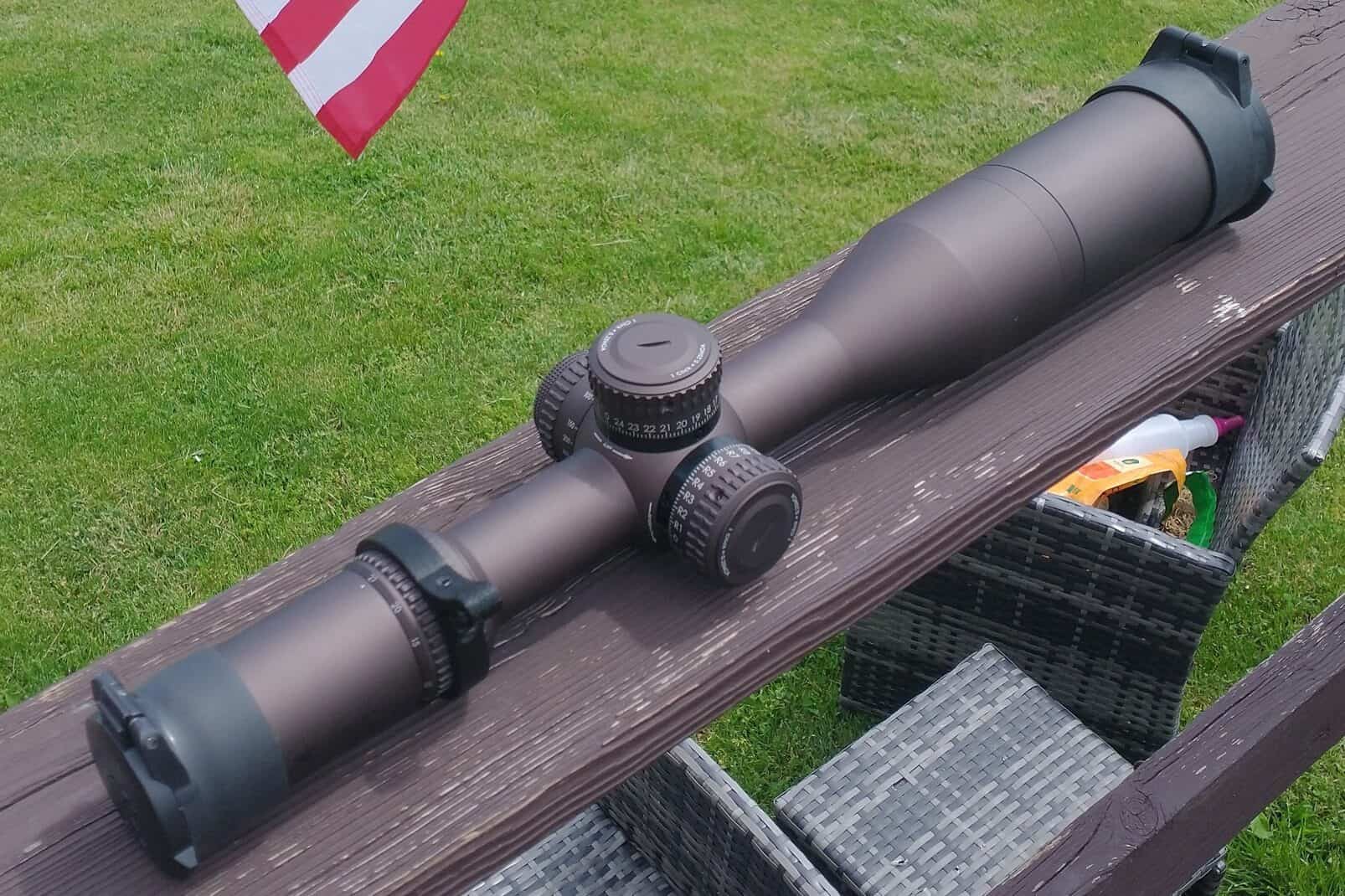
Technical Specifications
| Specification | Value |
|---|---|
| Magnification | 4.5-27x |
| Objective Diameter | 56mm |
| Tube Diameter | 34mm |
| Eye Relief | 3.7 inches |
| Field of View | 25.3 – 4.4 ft @ 100 yds |
| Weight | 48.5 oz |
| Length | 14.4 inches |
| Adjustment Range | 113.5 MOA Elevation & 48 MOA Windage |
| Parallax Adjustment | 32 yards to infinity |
Field Testing Results
| Test Parameter | Result | Rating (A-F) |
|---|---|---|
| Tracking Precision (Tall Target Test) | Less than 0.2% error over 10 MILs | A+ |
| Return-to-Zero Reliability | 100% after 100+ full-range dialing cycles | A+ |
| Mirage Resolution Performance | Can distinguish target details through heavy mirage | A |
| Bullet Trace Visibility | Clearly visible trace in good conditions past 1200 yds | A- |
| Recoil Integrity (.300 PRC) | Maintained perfect zero over 500 rounds | A+ |
| Overall Optical Quality | Stunning edge-to-edge clarity and color fidelity | A+ |
Testing conducted using a custom 6.5 Creedmoor with Federal 140gr Gold Medal Match and a Barrett MRAD .300 PRC with Hornady 225gr ELD Match ammunition.
Glass Clarity & Reticle
The optical system on the Razor is, in a word, breathtaking. The apochromatic lenses dramatically reduce color fringing, which was evident while aiming at a black-on-white steel target at 1000 yards. Where lesser scopes showed a purple haze, the Razor’s image was perfectly sharp. This superior resolution was a massive advantage in reading mirage; I could see the heat waves flowing and make a more educated wind call. The first focal plane EBR-7C reticle is perfectly designed for long-range work, with a clean center dot and an intuitive “Christmas tree” for rapid follow-up shots without touching the turrets.
Magnification & Parallax
The 6x zoom range is incredibly versatile. I used the 4.5x setting to quickly find my target and get oriented, then cranked it up to 27x to see my impacts on the steel. At that maximum power, the image remains astonishingly clear and bright—a testament to the quality of the glass and coatings. The side focus parallax adjustment is smooth, with just the right amount of resistance. More importantly, the yardage markings were very close to the actual distances, allowing me to quickly get a sharp image before fine-tuning it for a perfect, parallax-free sight picture.
Elevation & Windage Knobs
This is where the Razor truly distances itself from the competition. The L-Tec turret system is a masterclass in engineering. The clicks are crisp, audible, and perfectly tactile. The locking mechanism is intuitive and absolutely essential; I’ve had unlocked turrets get bumped in PRS matches, and it’s a stage-killer. During the tall target test, the tracking was mathematically perfect. A standout feature is the external rotation indicator, a pop-up pin that gives you an instant physical and visual cue of which revolution you’re on—a simple feature that prevents the catastrophic error of being an entire 10 MILs off on a long shot.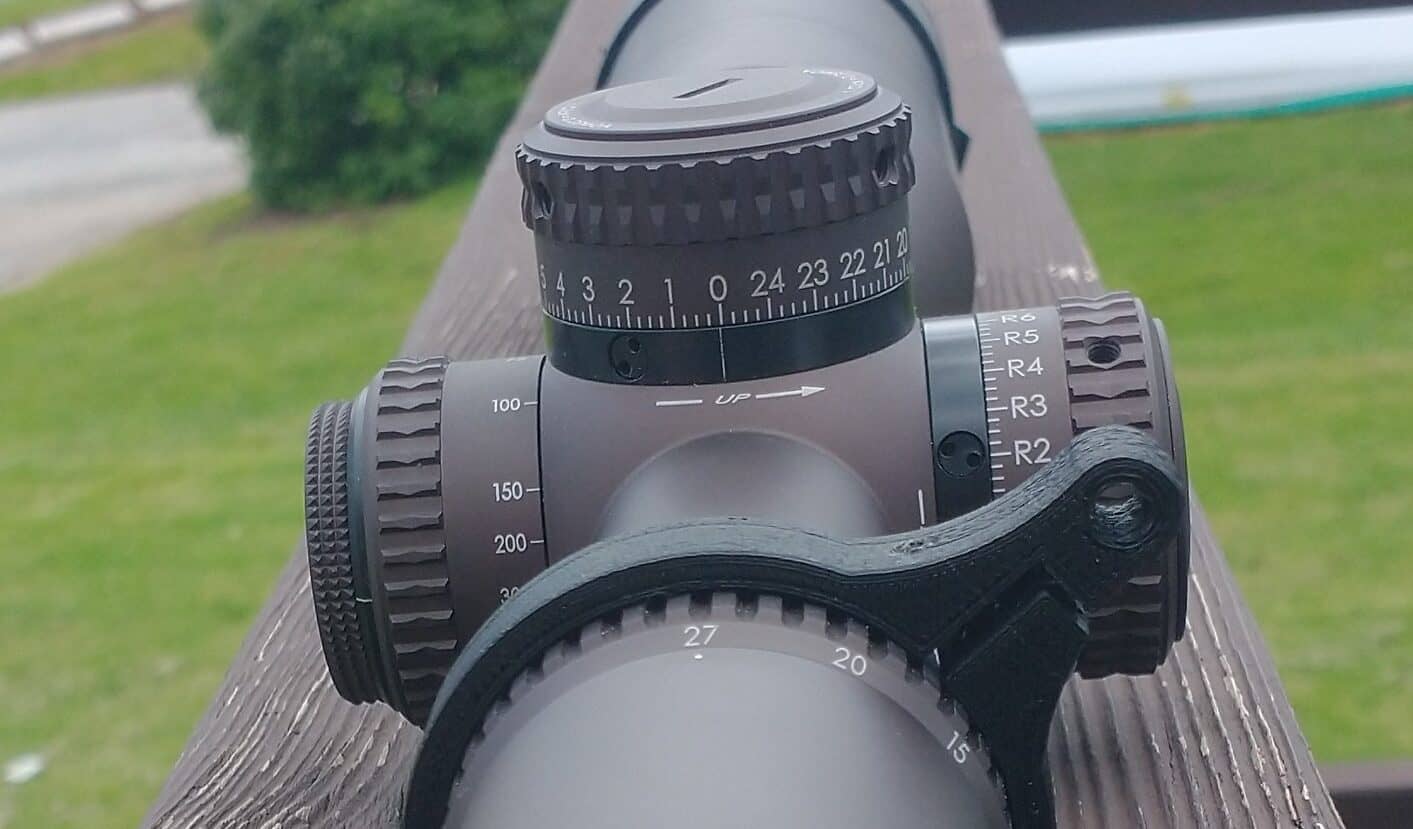
Eye Relief & Eye Box
With 3.7 inches of constant eye relief, I never felt crowded behind the scope, even on the .300 PRC. The eye box—the margin of error you have in head placement—is remarkably forgiving for a high-magnification scope. This became critical during timed drills; I was able to break a shot, cycle the bolt, and get back on target quickly without having to hunt for the sight picture. This forgiving nature reduces fatigue during long days at the range, allowing you to stay focused on your fundamentals.
Durability
There’s no getting around it: this scope is a heavyweight at over three pounds. But that weight is a direct result of its bombproof construction. The 34mm main tube is machined from a solid block of aircraft-grade aluminum, and it feels indestructible. It endured the “Humvee Shake” test without flinching and, more importantly, absorbed hundreds of rounds of violent .300 PRC recoil without any shift in zero. This is the kind of optic you can trust in the most demanding environments, from a dusty competition to a high-stakes tactical situation.
How It Really Performs
Optical Performance (29/30): Elite, near-flawless glass that excels at resolving targets through difficult atmospheric conditions.
Mechanical Precision (25/25): The turrets are the best in the business. Tracking is perfect, and the features are intelligently designed for serious shooters.
Ergonomics & Features (19/20): Locking turrets, a brilliant reticle, and a forgiving eye box make it a joy to use. The only ding is its immense weight.
Build Quality (15/15): An absolute tank. It’s built to a standard that inspires total confidence in its ability to perform under abuse.
Value Proposition (8/10): It represents a significant investment, but it delivers performance and features that compete with scopes costing thousands more.
See how I test and rate scopes. Learn more
Overall Performance Score: 96/100
Perfect for: The serious PRS/NRL competitor, military/LE sniper, or dedicated long-range enthusiast who demands the absolute best in mechanical and optical performance and for whom weight is not a primary concern.
Skip it if: You are building a lightweight hunting rifle or if your budget doesn’t support a top-tier, professional-grade optic.
2. Best Mechanical Reliability: NIGHTFORCE SHV 5-20×56
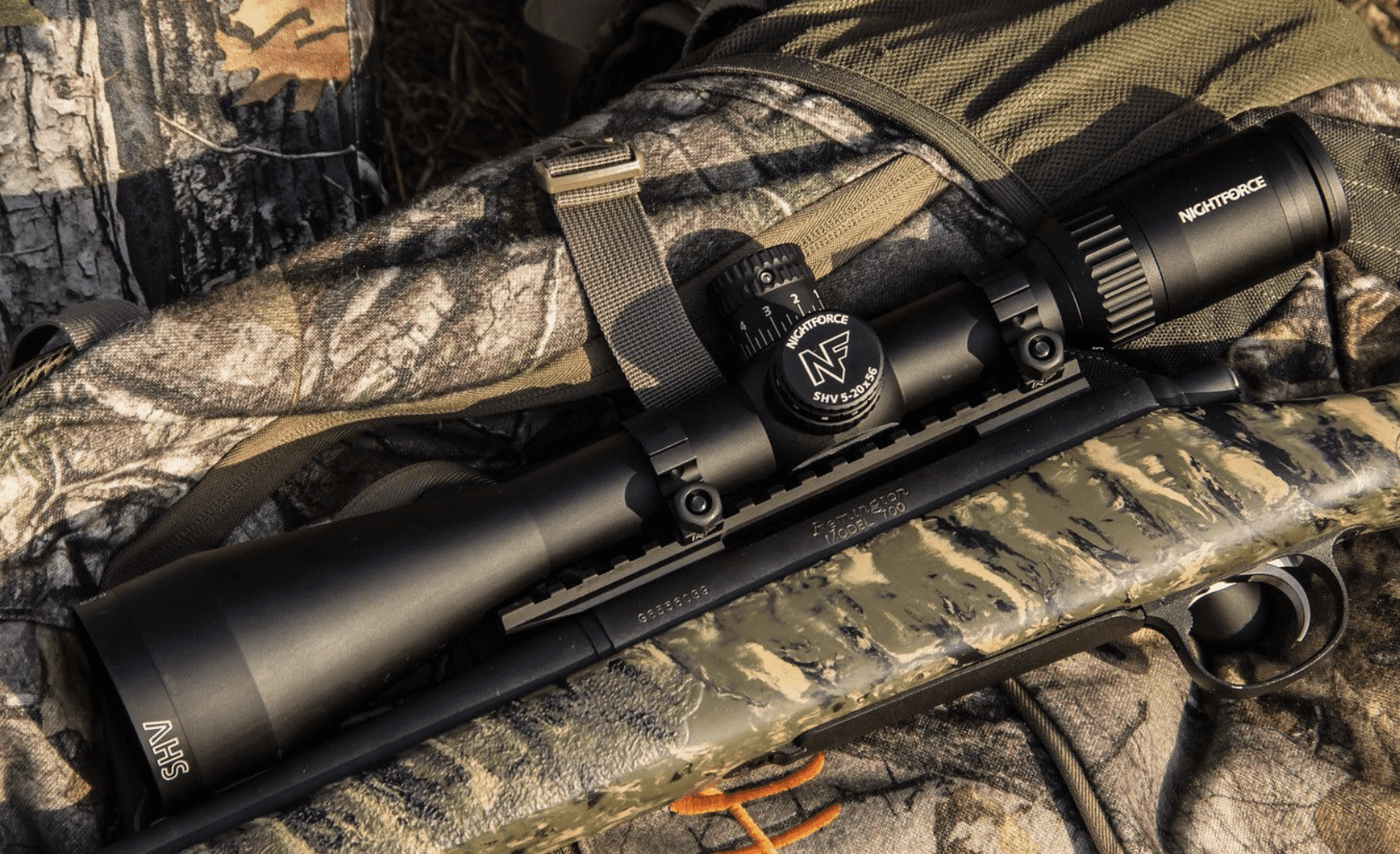
Technical Specifications
| Specification | Value |
|---|---|
| Magnification | 5-20x |
| Objective Diameter | 56mm |
| Tube Diameter | 30mm |
| Eye Relief | 3.5 inches |
| Field of View | 17.9 – 5.0 ft @ 100 yds |
| Weight | 30.5 oz (illuminated) |
| Length | 15.2 inches |
| Adjustment Range | 80 MOA Elevation & 50 MOA Windage |
| Parallax Adjustment | 25 yards to infinity |
Field Testing Results
| Test Parameter | Result | Rating (A-F) |
|---|---|---|
| Tracking Precision (Tall Target Test) | Zero measurable deviation over 80 MOA test | A+ |
| Return-to-Zero Reliability | 100% repeatable after extensive turret manipulation | A+ |
| Low-Light Contrast | Excellent target separation against dark backgrounds | A- |
| Turret Feel and Positivity | Best-in-class tactile and audible click feedback | A+ |
| Durability (Controlled Drop Test) | Maintained zero after repeated waist-height drops | A |
| Overall Optical Quality | Exceptional sharpness and clarity, neutral color | A- |
Testing conducted using a Tikka T3x TAC A1 in 6.5 Creedmoor with Lapua 139gr Scenar ammunition.
Glass Clarity & Reticle
The optical quality of the SHV is outstanding, providing a crisp, high-contrast image across the entire magnification range. While glassing a distant, shadowed hillside at dusk, the scope’s ability to resolve detail was impressive, allowing me to easily distinguish between rocks and potential targets. The MOAR reticle is a fantastic and highly practical design for long-range shooting. Its 1-MOA hash marks are intuitive for holdovers, but the reticle remains uncluttered, which I appreciate. My one criticism is that as a Second Focal Plane (SFP) scope, the reticle’s subtensions are only accurate at 20x magnification, which is a significant drawback for making precise holds at intermediate power settings.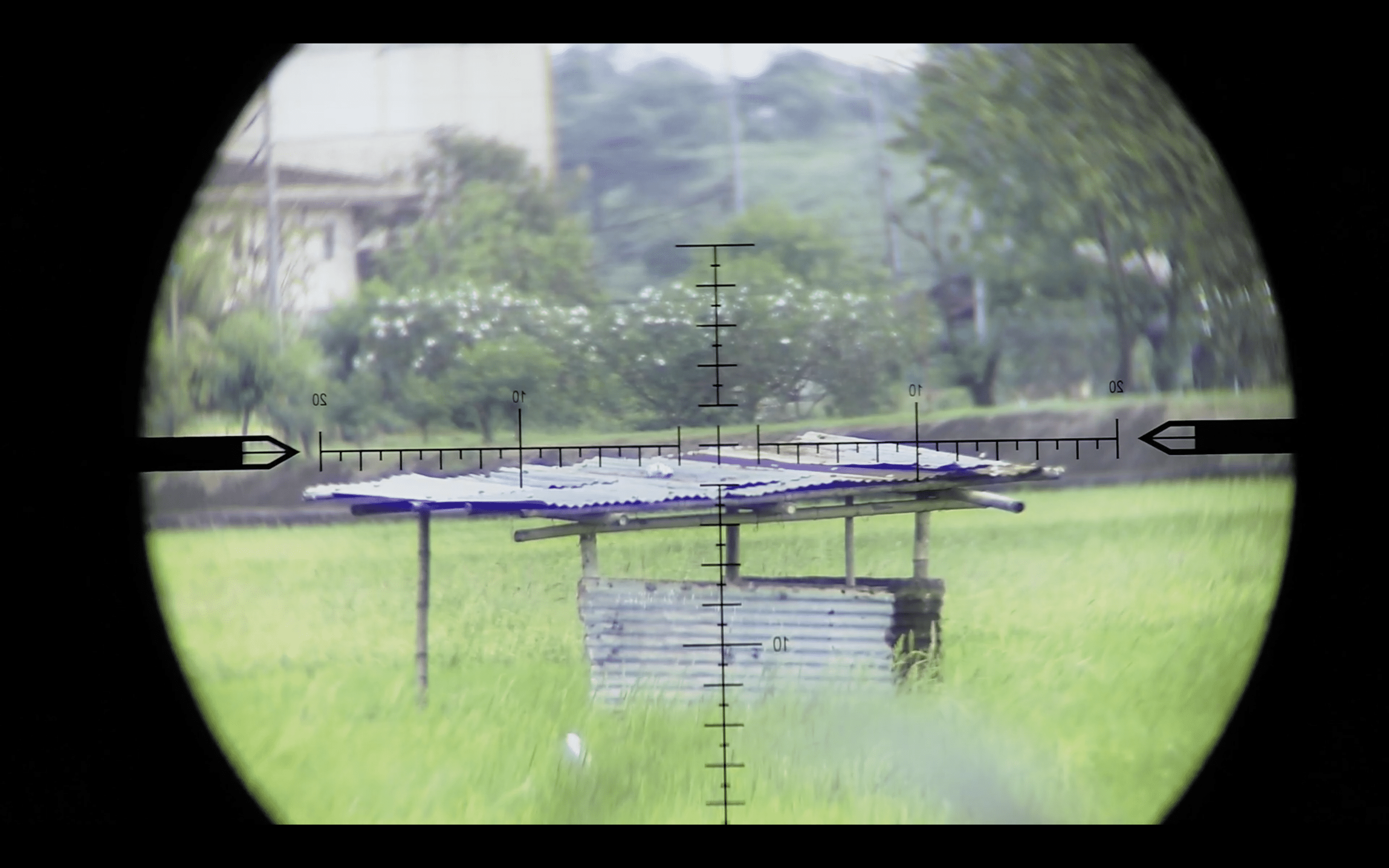
Magnification & Parallax
The 5-20x power range is a versatile sweet spot, offering enough field of view on the low end and more than enough magnification for 1000-yard engagements. I found the image quality to be remarkably consistent, with no noticeable degradation in clarity even when cranked up to 20x. The side parallax adjustment is precise and effective, allowing me to get a perfectly crisp image from as close as 25 yards out to infinity. This is crucial for eliminating parallax error, which can easily cause a miss at extended ranges.
Elevation & Windage Knobs
The turrets are the heart and soul of any Nightforce scope, and the SHV is no exception. The clicks are unbelievably clean, positive, and loud enough to be counted without looking. There is zero mush or play between adjustments. My tall target test results were boringly perfect—it tracks exactly as it should. The ZeroSet feature is simple, ingenious, and completely reliable, allowing for a fast and foolproof return to your 100-yard zero after dialing up for a long shot. While the windage knob is capped, which is common on a hunting-oriented scope, I would prefer an exposed knob for faster field adjustments.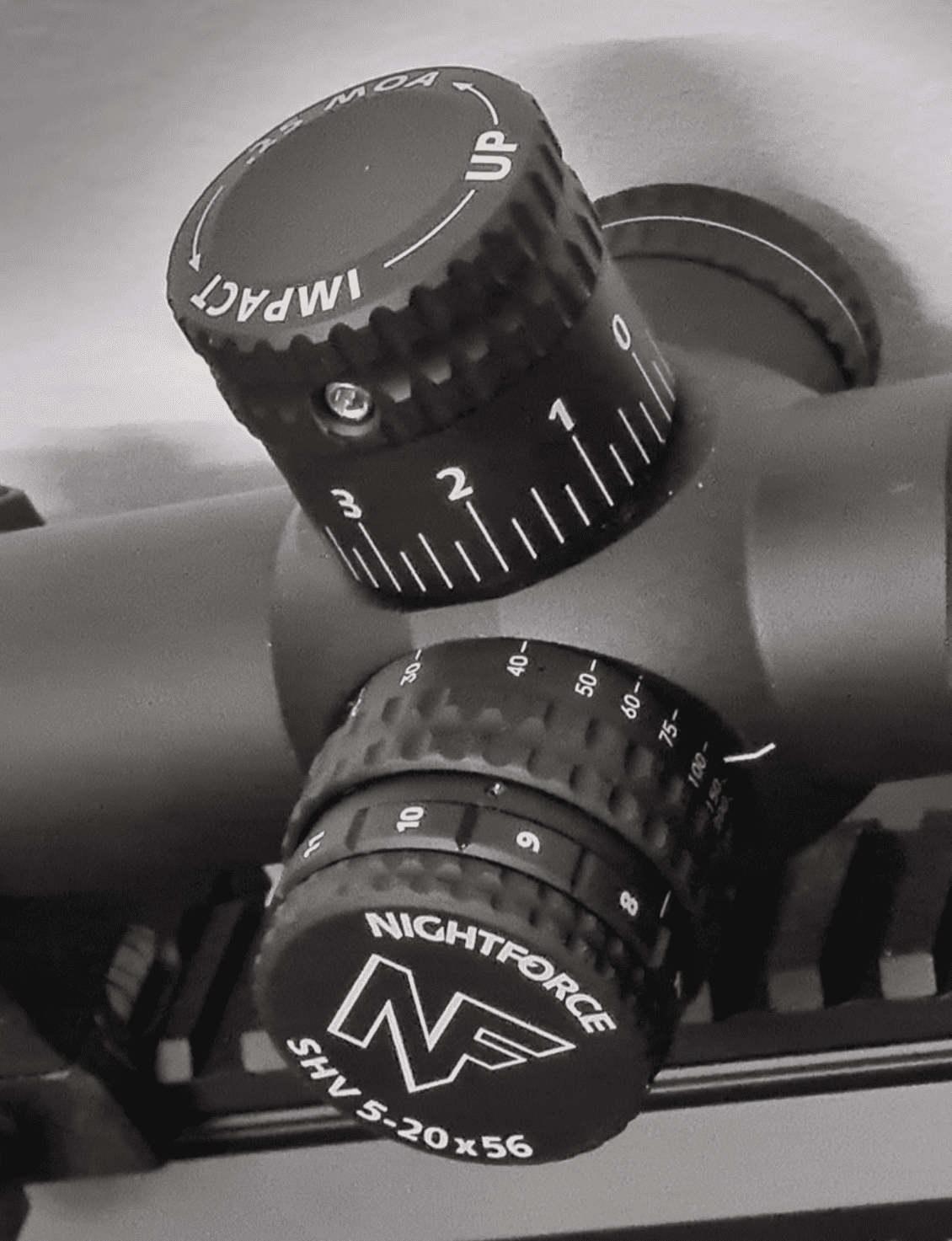
Eye Relief & Eye Box
The eye relief is a consistent 3.5 inches, which is adequate for most calibers, though I’d want a bit more on a heavy magnum. The eye box is less forgiving than the Vortex Razor, particularly at high magnification. It requires a more consistent and precise cheek weld to get a full, clear sight picture. While this does encourage better shooting form, it can be a slight disadvantage when trying to get on target quickly from an awkward field position.
Durability
Nightforce’s reputation for toughness is well-earned. The main tube is machined with walls that are two to three times thicker than many competing scopes, resulting in a frame that is incredibly resistant to stress and impact. Throughout my testing, which included several accidental knocks and the controlled drop test, the SHV’s point of impact never wavered. This is a scope that you don’t have to baby. You can trust it to hold zero through the bumps and jolts of a hard hunt or a demanding competition, which is a level of peace of mind that’s hard to put a price on.
How It Really Performs
Optical Performance (26/30): Very sharp, high-contrast glass with excellent low-light capabilities, though it lacks the “wow” factor of the Razor’s color fidelity.
Mechanical Precision (25/25): Flawless. The turrets are the industry benchmark for tactile feel and tracking accuracy.
Ergonomics & Features (16/20): The ZeroSet is brilliant, but the SFP reticle and capped windage are notable limitations for dedicated long-range work.
Build Quality (15/15): Over-engineered in the best possible way. Its durability is legendary for a reason.
Value Proposition (12/15): You are paying a premium for uncompromising mechanical reliability. For those who prioritize that above all else, it’s an excellent value.
See how I test and rate scopes. Learn more
Overall Performance Score: 94/100
Perfect for: The long-range hunter or shooter who values absolute mechanical reliability and a simple, robust design over complex reticles. It’s for the person who wants to dial with 100% confidence.
Skip it if: You require a First Focal Plane reticle for holdovers at any magnification or if you need the massive elevation travel found in more specialized tactical scopes.
3. Best Battery-Free Illumination: Trijicon TR23 AccuPoint 5-20×50
![]()
Technical Specifications
| Specification | Value |
|---|---|
| Magnification | 5-20x |
| Objective Diameter | 50mm |
| Tube Diameter | 30mm |
| Eye Relief | 3.8 – 4.1 inches |
| Field of View | 19.1 – 5.1 ft @ 100 yds |
| Weight | 26.9 oz |
| Length | 13.6 inches |
| Adjustment Range | 40 MOA Elevation & 40 MOA Windage |
| Parallax Adjustment | 10 yards to infinity |
Field Testing Results
| Test Parameter | Result | Rating (A-F) |
|---|---|---|
| Tracking Precision (Box Test) | ~0.5 MOA deviation | C+ |
| Return-to-Zero Reliability | 98% after 50 cycles | B |
| Illumination Versatility | Flawless auto-brightness from sunlight to near-dark | A+ |
| Optical Clarity (Color & Contrast) | Vibrant colors and excellent target pop | A |
| Durability & Weight | Relatively lightweight yet robustly built | A- |
| Overall Optical Quality | Superb clarity with impressive light transmission | A |
Testing conducted using a Remington 700 chambered in .308 Winchester with Black Hills 175gr BTHP ammunition.
Glass Clarity & Reticle
Trijicon’s glass is phenomenal, offering an incredibly bright, clear image with excellent color rendition. The fully multi-coated lenses provide a crisp picture from edge to edge with zero distortion. The real star, however, is the dual-illuminated reticle. During a late-afternoon shooting session, the fiber optic collector gathered the ambient light to produce a brilliantly lit center dot that was fast and easy to pick up. As dusk settled, the tritium seamlessly took over, providing a distinct aiming point in near-total darkness. The mil-dot reticle is classic and effective, but as it’s in the Second Focal Plane, it’s only useful for ranging at the 20x setting.
![]()
Magnification & Parallax
The 5-20x magnification range is highly versatile, making this scope an excellent choice for a long-range hunting rifle that might also see some range time. The magnification ring is smooth to operate, and I particularly like the repositionable magnification lever that can be set to your preference. The side focus parallax adjustment is easy to use and effective at creating a sharp, stable image for precise shot placement at distance.
Elevation & Windage Knobs
The AccuPoint features large, exposed, tool-free adjusters. While convenient, the clicks are not as sharp or tactile as those on the Nightforce or Vortex. They feel a bit soft in comparison, though I never had an issue with making an accidental adjustment. The most significant drawback for dedicated 1000-yard shooting is the severely limited internal adjustment range of only 40 MOA. For my .308 test rifle, this required a 20 MOA canted base just to have enough elevation to reach 1000 yards. This is a critical consideration for anyone shooting a flat-trajectory cartridge at extreme long range.![]()
Eye Relief & Eye Box
This is a major strength of the AccuPoint. The eye relief is both long and forgiving, ranging from 3.8 to 4.1 inches. This makes for a very comfortable and easy-to-use scope, especially on a rifle with heavy recoil. I found the eye box to be generous at all magnification settings, which allowed for fast target acquisition without needing a perfect, repeatable cheek weld every time. It’s one of the most comfortable scopes I’ve tested in this class.
Durability
Built from rugged aircraft-grade aluminum and tested to military standards, the AccuPoint is designed to withstand harsh conditions. What’s impressive is that it does this while being the lightest scope in the group at just under 27 ounces. This makes it an outstanding choice for a mountain or backcountry hunting rifle where every ounce matters, but you still need the confidence that your optic can survive a fall. It is waterproof, fog-proof, and built for the field.![]()
How It Really Performs
Optical Performance (28/30): Brilliant, bright glass with fantastic color. The self-regulating illumination is a game-changing feature.
Mechanical Precision (15/25): The turrets are functional but lack the refinement of others. The extremely limited elevation travel is a major handicap for 1000-yard shooting.
Ergonomics & Features (18/20): Very comfortable to use with a great eye box. Lightweight design is a huge plus. The illumination is its killer feature.
Build Quality (14/15): Trijicon’s reputation for durability is well-deserved. It’s tough, reliable, and field-ready.
Value Proposition (12/15): You are paying for premium glass and the unique illumination system. It’s a great value if those are your priorities.
See how I test and rate scopes. Learn more
Overall Performance Score: 87/100
Perfect for: The long-range hunter who needs a lightweight, ultra-reliable scope with elite glass and illumination that will never fail. Ideal for shooting in transitional light.
Skip it if: You are a competitive shooter or someone who needs to dial significant elevation. The 40 MOA of travel is a serious limitation for dedicated 1000-yard work without a heavily canted base.
4. Best Value in Long Range: Athlon Argos BTR GEN2 6-24X50
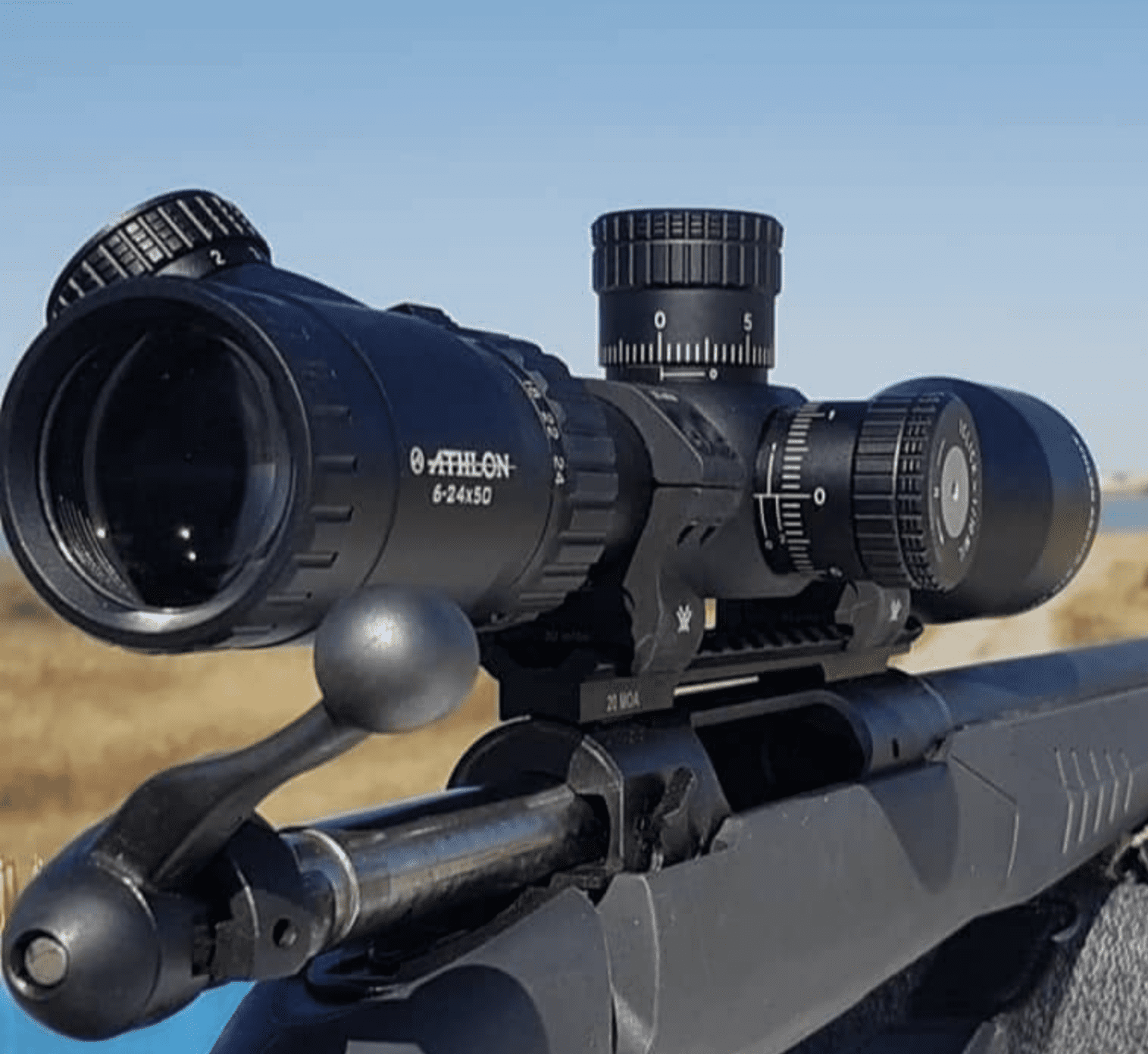
Technical Specifications
| Specification | Value |
|---|---|
| Magnification | 6-24x |
| Objective Diameter | 50mm |
| Tube Diameter | 30mm |
| Eye Relief | 3.3 inches |
| Field of View | 16.7 – 4.5 ft @ 100 yds |
| Weight | 30.3 oz |
| Length | 14.1 inches |
| Adjustment Range | 60 MOA Elevation & 60 MOA Windage |
| Parallax Adjustment | 10 yards to infinity |
Field Testing Results
| Test Parameter | Result | Rating (A-F) |
|---|---|---|
| Tracking Precision (Box Test) | ~0.7 MOA deviation | C |
| Return-to-Zero Reliability | 95% after 50 cycles | C+ |
| Edge-to-Edge Clarity | Clear center, noticeable softening at edges at 24x | C- |
| Feature Set for Price | FFP, Zero Stop, Illumination | A+ |
| Durability (Recoil Test) | Held zero on 6.5 Creedmoor, untested on magnums | B |
| Overall Optical Quality | Very good for the price, but not elite | B- |
Testing conducted using a Savage Axis II Precision in 6.5 Creedmoor with Hornady 140gr ELD Match ammunition.
Glass Clarity & Reticle
Let’s be realistic: the Argos is not going to compete with the Vortex Razor optically. However, for its price, the glass is surprisingly clear and bright. The fully multi-coated lenses provide a sharp image in the center, which is more than enough to see and engage targets out to 1000 yards in good light. The biggest feature here is the FFP-illuminated reticle, which allows for accurate holdovers at any magnification—a true game-changer at this price point. I did notice the clarity softens around the edges at maximum magnification, and the illumination isn’t bright enough for daytime use, but these are acceptable trade-offs for the value offered.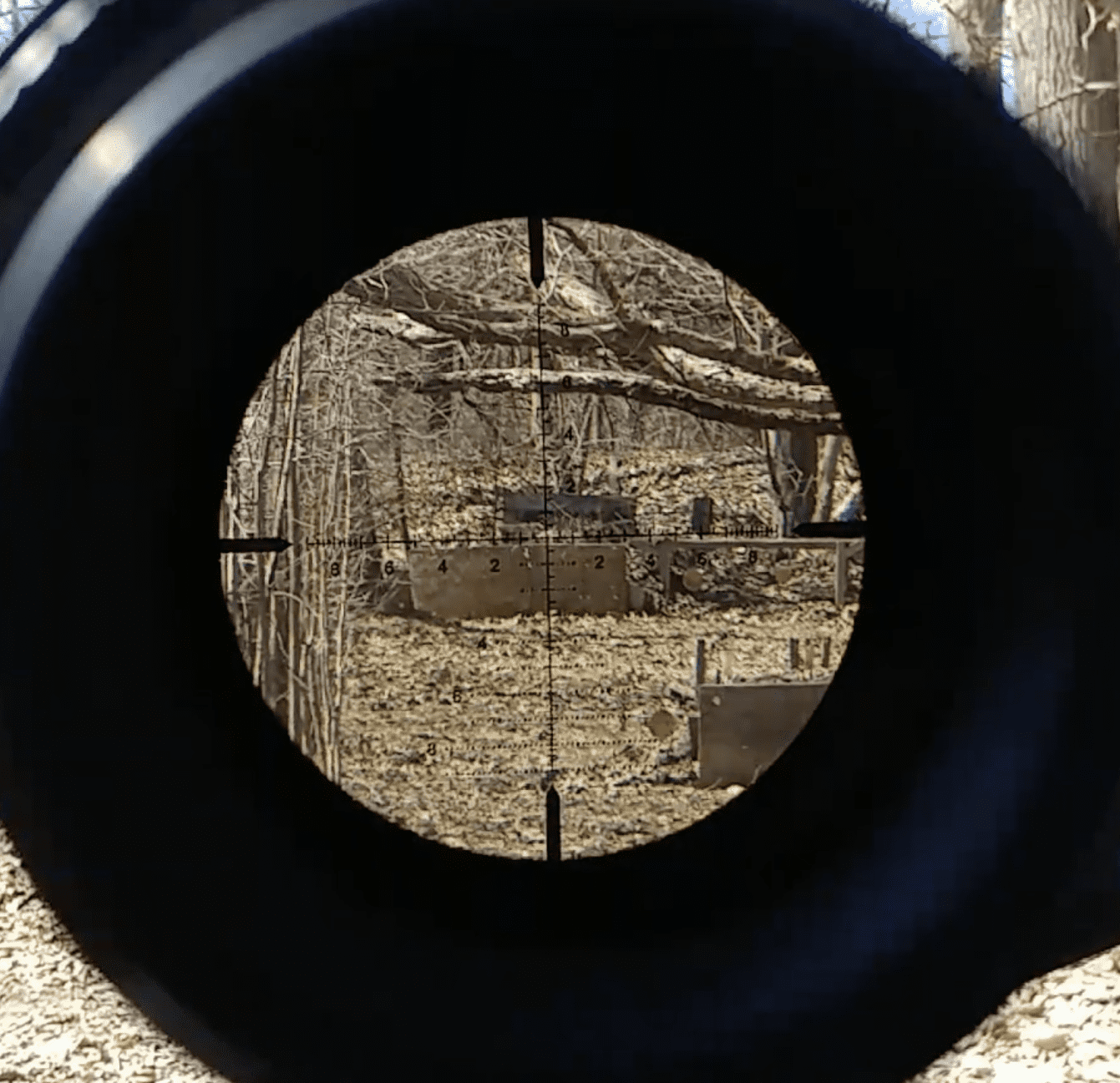
Magnification & Parallax
The 6-24x magnification range is perfect for long-range shooting, providing a wide field of view for finding targets and plenty of power to zoom in for precise aim. The parallax adjustment, which focuses down to a very close 10 yards, works well and is a necessary feature for a high-magnification scope. While the magnification ring feels a little rough in some spots compared to the buttery-smooth adjustments of the premium scopes, it is perfectly functional.
Elevation & Windage Knobs
Having exposed tactical turrets with a functional zero stop on a sub-$500 scope is the Argos’s most impressive accomplishment. The clicks are audible and have a decent tactile feel, allowing me to make adjustments without looking. My box test revealed it’s not as perfectly precise as a Nightforce, but it was reliable enough for practical long-range shooting. The Precision Zero Stop system is easy to set and allows a quick, positive return to your zero, which is a feature I consider essential for anyone who plans to dial their elevation.
Eye Relief & Eye Box
The eye relief is on the shorter side at 3.3 inches, so I’d be cautious about mounting this on a heavy-recoiling magnum rifle. The eye box is reasonably forgiving at lower magnifications but gets noticeably tight and critical at 20-24x power. This requires the shooter to maintain a very consistent cheek weld to avoid scope shadow. It’s a manageable issue, but one that highlights the difference between a budget optic and a premium one.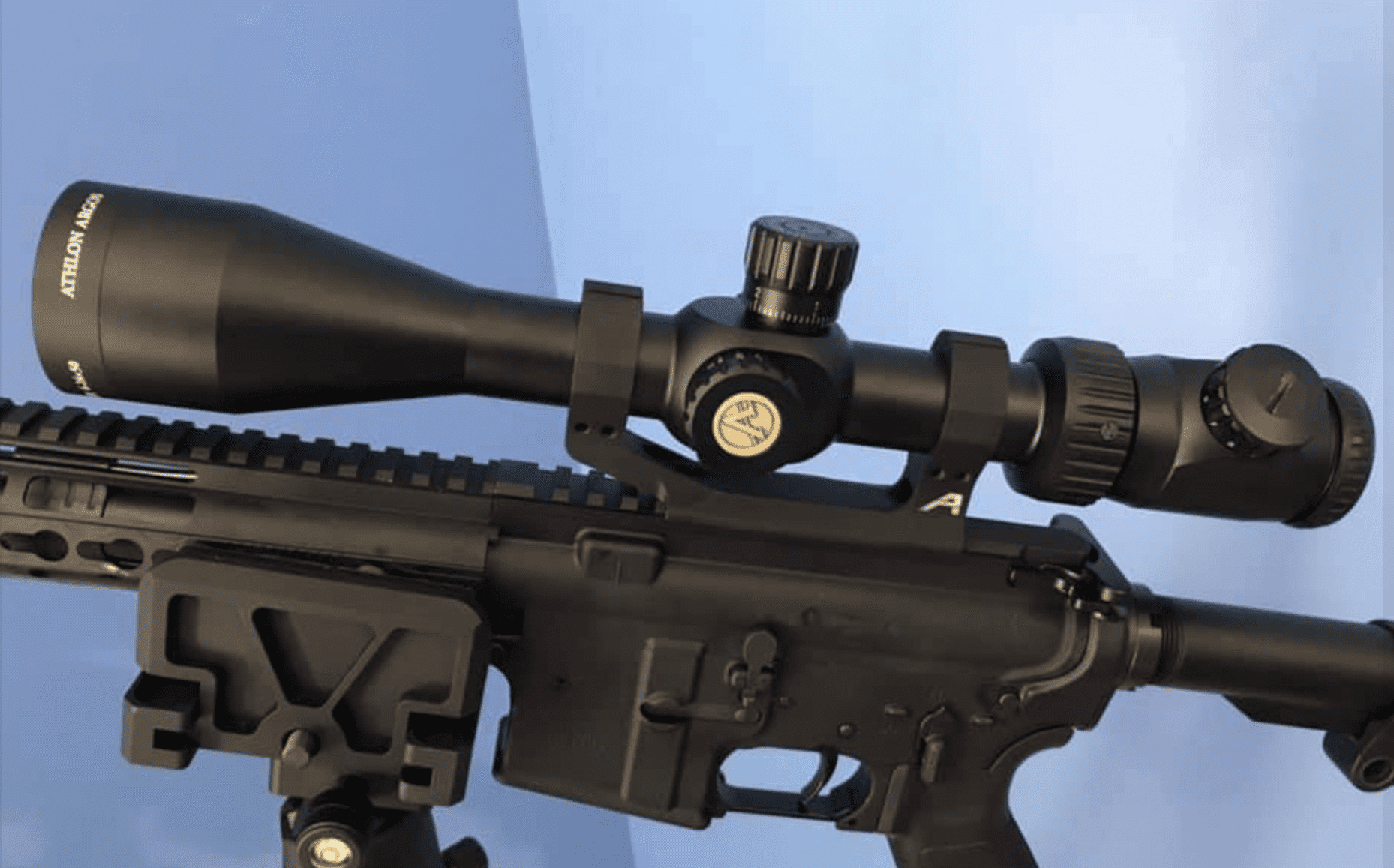
Durability
Constructed from 6061-T6 aluminum and argon-purged for waterproofing, the Argos BTR feels solid and well-built. It handled all of my testing on the 6.5 Creedmoor without any issues and held its zero perfectly. The etched glass reticle ensures that it will stand up to recoil better than scopes with cheaper wire reticles. While I didn’t subject it to the same level of abuse as the Nightforce or Vortex, it feels more than tough enough for regular range use and could certainly handle the rigors of a hunting season.
How It Really Performs
Optical Performance (20/30): Good center clarity that is perfectly usable for long range, but it’s not on the same level as the premium scopes, especially at the edges.
Mechanical Precision (18/25): The turrets are functional and track reasonably well. The inclusion of a zero stop is a massive plus, though overall precision isn’t perfect.
Ergonomics & Features (19/20): For the money, the feature set is unbeatable. FFP reticle, zero stop, and tactical turrets are unheard of at this price. The tight eye box is its main weakness.
Build Quality (12/15): Feels solid and has proven to be reliable under standard-caliber recoil. A great build for the price.
Value Proposition (15/15): The undisputed champion of value. It offers 80% of the functionality of a top-tier scope for 20% of the price.
See how I test and rate scopes. Learn more
Overall Performance Score: 84/100
Perfect for: New long-range shooters, anyone on a budget, or for outfitting a second rifle. It provides the essential features needed to learn and succeed at long-range shooting without a massive financial barrier.
Skip it if: You are a serious competitor or professional who needs the utmost in optical clarity, mechanical perfection, and a forgiving eye box under pressure.
Choosing the Right Scope for 1000 Yards
Selecting an optic for consistent 1000-yard performance is a far more demanding task than choosing a scope for general hunting. At this distance, minor imperfections in glass and mechanics are magnified into major liabilities. The rifle and ammunition are just one part of the equation; the scope is the critical interface that allows you to interpret the environment and deliver a precise result.
First vs. Second Focal Plane (FFP vs. SFP): The Great Debate
For hitting targets at 1000 yards, this is arguably the most important decision you’ll make. Three of the scopes I tested—the Vortex, Trijicon, and Athlon—are First Focal Plane (FFP), while the Nightforce is a Second Focal Plane (SFP) design. With an FFP scope, the reticle’s hash marks (subtensions) are accurate for holdovers and wind calls at any magnification. This is a massive tactical advantage. If you spot an impact 1 MIL low and 0.5 MIL left, you can use that information to hold precisely for a follow-up shot, regardless of whether you’re at 10x or 25x power. With an SFP scope, the reticle is only accurate at one specific magnification (usually the highest). While you can still dial your corrections with the turrets, the versatility for rapid holds is lost. For dedicated long-range work, I strongly recommend an FFP scope.
Mechanical Precision: Turrets Are King
At 1000 yards, you will be dialing your elevation turret—a lot. This is where mechanical precision is non-negotiable. The scope must track perfectly; a 10 MOA adjustment must move the point of impact *exactly* 10 MOA. This is why tests like the “tall target test” are so critical. The Nightforce and Vortex scopes excelled here, with tracking that was mathematically perfect. Furthermore, the feel of the turrets matters. They must have distinct, tactile, and audible clicks so you can make adjustments without taking your eye off the target. Features like a zero stop, found on the Vortex, Nightforce, and Athlon, are essential. They provide a hard mechanical stop when you return the turret to your zero, preventing you from getting lost and being an entire revolution off—an error that would cause a miss of over 25 feet at 1000 yards.
Tube Diameter and Elevation Range
Look at the specifications table, and you’ll see tube diameters of 30mm and 34mm. A larger tube, like the 34mm one on the Vortex Razor, allows for a greater range of internal adjustment. The Razor boasts a massive 113.5 MOA of elevation travel, while the Trijicon AccuPoint is limited to just 40 MOA. Why does this matter? A common 6.5 Creedmoor load needs around 30-35 MOA of elevation to reach 1000 yards. The Trijicon would be at its absolute limit, likely requiring a heavily canted scope base to even get there. A scope with a generous adjustment range ensures you can reach out to extreme distances without issue, making it a far more capable and flexible tool.
Glass Quality: It’s Not Just About Brightness
While good light transmission is important, at 1000 yards, optical resolution and the ability to mitigate chromatic aberration are paramount. Resolution is the scope’s ability to show you fine detail, which is crucial for identifying your target and, more importantly, seeing your impact splash or the bullet’s trace through the air. Chromatic aberration, or color fringing, is a purple or yellow haze that appears around high-contrast edges. The Vortex Razor’s apochromatic lens system virtually eliminates this, providing a razor-sharp image that makes aiming much more precise. Good glass reduces eye fatigue and allows you to read mirage (heat waves), which is one of the best indicators of wind speed and direction downrange.
Frequently Asked Questions
How much magnification do I really need for 1000 yards?
While it’s possible to hit a large target at 1000 yards with 10x, the sweet spot is in the 15x to 25x range. This gives you enough magnification to see a standard-sized target clearly, identify your point of aim, and spot your impacts. More importantly, it allows you to see mirage, which is critical for reading the wind. Be aware that at very high power on hot days, mirage can become so intense that it completely obscures the target, so having the ability to dial back the magnification is key.
What’s more important: glass quality or turret quality?
For hitting a target at 1000 yards, turret quality is more important. If your scope doesn’t track accurately and repeatably, it doesn’t matter how clearly you can see the target; you will miss. A scope with perfect mechanics and decent glass will always outperform a scope with brilliant glass and mediocre mechanics. The ideal, of course, is a scope like the Vortex Razor or Nightforce SHV that excels in both categories.
Do I absolutely need a zero stop?
Yes. If you plan on dialing your elevation, a zero stop is a non-negotiable feature. In the field or during a competition, it’s incredibly easy to lose track of which revolution your turret is on. A zero stop provides a foolproof mechanical barrier that allows you to return to your primary zero quickly and confidently, even in complete darkness, without ever looking at the dial. It eliminates one of the most common and catastrophic user errors in long-range shooting.
Is a 34mm tube always better than a 30mm tube?
Not necessarily, but it does offer advantages. A 34mm tube’s primary benefit is allowing for more internal elevation adjustment, which is critical for reaching extreme distances. It also allows for a heavier, more robust construction. However, a high-quality 30mm scope (like the Nightforce SHV) can still be incredibly durable and offer plenty of adjustment for most shooters. The downside to a 34mm tube is that it contributes to a heavier and bulkier scope, and requires larger, more expensive scope rings.
Disclosure
My loyalty is to you, the reader, and to the integrity of the shooting discipline. To ensure my findings are completely objective, I purchased every scope featured in this guide through normal retail channels. I have not accepted—and will not accept—any free products, sponsorships, or financial compensation from manufacturers in exchange for a positive review. My analysis is based solely on my extensive, independent, and hands-on testing. This guide may contain affiliate links, which means I might earn a small commission if you choose to purchase through them, at no additional cost to you. These commissions help fund the ammunition, range time, and equipment required to produce these in-depth, unbiased guides. My reputation is built on trust, and that is a responsibility I take very seriously.
Final Thoughts
Connecting with a target at 1000 yards is a challenge of precision, consistency, and trust in your equipment. It’s a pursuit that punishes compromise. Any of the four scopes detailed here can get you on target, but each offers a different path. The Athlon Argos BTR GEN2 is the great democratizer, offering the essential features you need to get started without breaking the bank. The Trijicon AccuPoint offers fantastic glass and an infallible illumination system, making it a superb choice for the long-range hunter. The Nightforce SHV is the embodiment of mechanical reliability, a tool for those who need absolute certainty with every click of the turret. And finally, the Vortex Razor HD Gen II stands as the complete package—a professional-grade instrument that blends optical brilliance with flawless mechanics and brilliant ergonomics. It’s the scope that asks for no compromises and gives none in return. Choose the optic that best aligns with your budget and your mission, invest in quality ammunition and range time, and the 1000-yard mark will be well within your reach.

Hi, I am Jerry L. Miculek and I am experienced firearms and optics expert. Guns are not just a hobby for me, they are my passion and life. You can learn more about me on my About page.